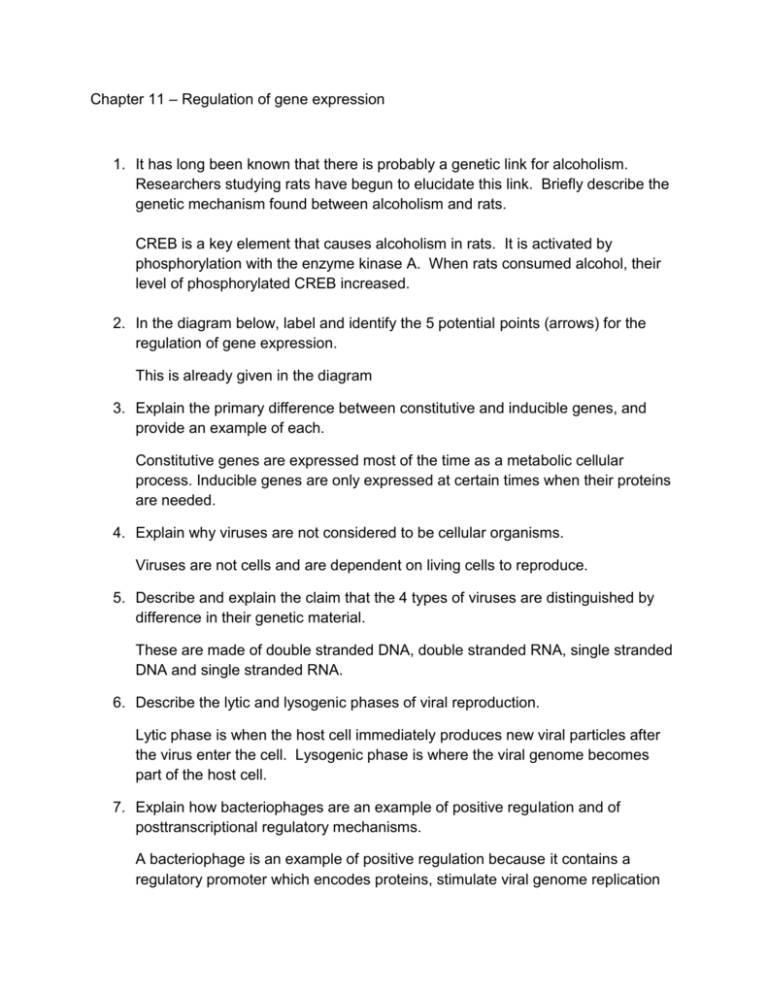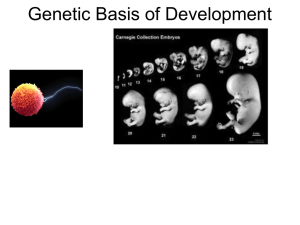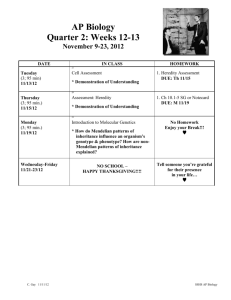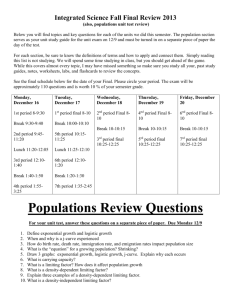Gene regulation - Pravda Quinones
advertisement

Chapter 11 – Regulation of gene expression 1. It has long been known that there is probably a genetic link for alcoholism. Researchers studying rats have begun to elucidate this link. Briefly describe the genetic mechanism found between alcoholism and rats. CREB is a key element that causes alcoholism in rats. It is activated by phosphorylation with the enzyme kinase A. When rats consumed alcohol, their level of phosphorylated CREB increased. 2. In the diagram below, label and identify the 5 potential points (arrows) for the regulation of gene expression. This is already given in the diagram 3. Explain the primary difference between constitutive and inducible genes, and provide an example of each. Constitutive genes are expressed most of the time as a metabolic cellular process. Inducible genes are only expressed at certain times when their proteins are needed. 4. Explain why viruses are not considered to be cellular organisms. Viruses are not cells and are dependent on living cells to reproduce. 5. Describe and explain the claim that the 4 types of viruses are distinguished by difference in their genetic material. These are made of double stranded DNA, double stranded RNA, single stranded DNA and single stranded RNA. 6. Describe the lytic and lysogenic phases of viral reproduction. Lytic phase is when the host cell immediately produces new viral particles after the virus enter the cell. Lysogenic phase is where the viral genome becomes part of the host cell. 7. Explain how bacteriophages are an example of positive regulation and of posttranscriptional regulatory mechanisms. A bacteriophage is an example of positive regulation because it contains a regulatory promoter which encodes proteins, stimulate viral genome replication and activate the transcription of viral genes. A posttranscriptional regulatory mechanism is when a virus encoded enzyme degrades the host’s RNA molecules before they can be translated. 8. Draw and label a diagram that shows how an infected cell attempts to utilize transcription terminator proteins to prevent a retrovirus from expressing itself. Include in your diagram: the nucleus, nuclear membrane and provirus. 9. Explain how HIV counteracts the process you described in your answer to the previous question on retrovirus protection. When HIV virus infects host cells, normally the host cells use negative regulatory systems as defense mechanisms to repress the expression of the invading viral genes. Then the HIV virus counteract these with a virus encoded protein called Tat which binds to the viral mRNA that allow RNA polymerase to transcribe the viral genome. 10. Describe the 3 primary parts of the lac operon. Promoter – DNA sequence to which RNA polymerase binds to initiate transcription. Operator – Region of the operon that controls transcription of the structural genes. Three structural genes – Encode the primary structures of proteins not involved in the regulation of gene expression. 11. Genetic mutations are useful in analyzing the control of gene expression. In the lac operon of E. coli, gene i codes for the repressor protein, Plac is the promoter, o is the operator and z is the first structural gene. (+) means wild (or normal) type; (-) means mutant. Fill in the table below by writing “YES” or “NO” in box of the following table describing the level of transcription in different genetic and environmental conditions. GENOTYPE i- Plac+ o+ z+ i- Plac+ o+ zi+ Plac+ o+ z+ i+ Plac+ o- z+ Z TRANSCRIPTION LEVEL LACTOSE PRESENT LACTOSE ABSENT YES YES NO NO NO NO YES YES 12. The Trp operon is a repressible operon. Explain what is meant when the Trp operon is described as a repressible operon, and how this regulatory function is important to a bacterial cell. The Trp operon is one that is switched off when its repressor is bound to its operator, but it binds to the DNA only when in presence of a co-repressor. 13. Describe two features of bacteria that make them especially useful for studying the mechanisms of gene regulation. It is useful because their arrangements are not as complex as eukaryotes. Functionally related genes are often clustered in operons, there is only one RNA polymerase and limited number of regulatory sequences to study. 14. Explain why transcription factors are found more commonly in eukaryotes than in prokaryotes. Because the regulation of transcription is more complex in eukaryotes. Prokaryotes have just one type of regulation and eukaryotic genes have several different types of regulation. 15. Describe all the necessary components that must be present before RNA polymerase II can transcribe a segment of DNA. TFIID binds to promoter, then another transcription factor binds. Then RNA polymerase II binds only after several transcription factors are bound to other proteins, RNA polymerase cannot initiate transcription until many transcription factors are attached. 16. In the diagram below, label: DNA, TATA box, transcription initiation site, promoter, transcription factors, and RNA polymerase II. 17. Describe the chemical matching between a transcription factor and the DNA sequence to which it can bind. When the atoms of transcription factor and DNA are exposed, interacting via hydrogen bonding, there are hydrophobic interactions between the DNA basees and amino acid R groups in the protein. 18. When a transcription factor binds to DNA, there is an induced fit. What is an induced fit and how does it occur? An induced fit occurs when the protein undergoes a conformational change after binding begins. This means that the shape of the enzyme is changed by binding to its substrate. 19. Discuss the functional importance of coordinated gene expression. It is important because coordinated gene expression is used by organisms to respond to stress. 20. Epigenetic changes to DNA alter gene expression without changing DNA sequences, and these changes are passed to offspring. Describe two different ways that epigenetic changes to DNA can occur, and describe how these changes can be inherited. One way is DNA methylation, which involves the addition of a methyl group in the new DNA strand, this can be inherited after mitosis or meiosis. Another way is the alteration of chromatin structure. Both types of epigenetic changes can result in phenotypic changes in daughter cells. 21. Early in life, identical twins are often difficult to tell apart and behave very similarly. As they age, subtle differences begin to appear and as they reach middle age, they often have distinct differences. Explain how this can occur at a molecular level with their DNA. Monozygotic twins share identical genomes but environmental characteristics play a very important role in the epigenetic modification. As these twins live their life separately, the regulation of phenotype and gene expression changes. 22. In Drosophila, sex is determined by a gene that has four exons, which we will designate 1, 2, 3 and 4. In the female embryo, splicing generates two active forms of the protein, containing exons 1 and 2, and 1, 2 and 4. However, in the male embryo, the protein contains all four exons (1, 2, 3 and 4) and is inactive. Draw a diagram similar to figure 11.16 that represents this process. 23. Explain how humans have approximately 24,000 genes, yet have at least 85,000 mRNA’s. Recent studies show that more than 80% of human genes are alternative spliced because there are many more mRNAs than genes. 24. In the figure below, label: targeted protein, ubiquitin and proteasome. 25. Explain the role of ubiquitin in the figure in the preceding question. Proteins that bind ubiquitin are targeted for degradation, because the protein is bound to ubiquitin and then the complex bound to a proteasome in the figure above, the ubiquitin is released and the proteasome hydrolyzes the target protein. 26. Explain why miRNA’s are considered to be a gene silencing mechanism. A protein complex guides the miRNA to its target mRNA where translation is inhibited and the mRNA degraded, this inhibition of translation is a silencing mechanism. 27. Complete the table below for the different types of gene regulation: Operons Transcription factors Translational Epigenetics Chromatin remodeling miRNA Alternative splicing Location in cell Molecule (s) acted on Example Prokaryotescytoplasm; eukaryotesnucleus DNA lacOperon in E. coli Prokaryotescytoplasm; eukaryotesnucleus DNA tumor suppressors tobacco horn-worm moth ribosomes RNA fertilized eggs nucleus DNA DNA methylation nucleus nucleosomes histone acetylation ribosomes mRNA early stage of breast cancer nucleus pre-mRNA HIV Ttranslational repressors ribosomes Proteasome eukaryote cytoplasm mRNA ubiquitin tagged cellular proteins Translation of ferritin increases with hgiher levels of free iron ions in humans Breakdown of proteins targeted for degradation bound by ubiquitin 28. In an experiment, fruit flies showed unusual outgrowths on their eyes. This trait lasted for 11-13 generations of offspring until breeding of fruit flies resulted in normal fruit flies. a. Could this change have occurred due to a mutation in the DNA sequence? Why or why not? This change was not caused by mutations in the DNA sequence. If that was the case, the change would be permanent and the original eye condition would not have returned. b. Explain how this change can occur and then result in normal fruit flies. Since there are not permanent changes to the DNA sequence, eventually the eye phenotype returns to normal.









